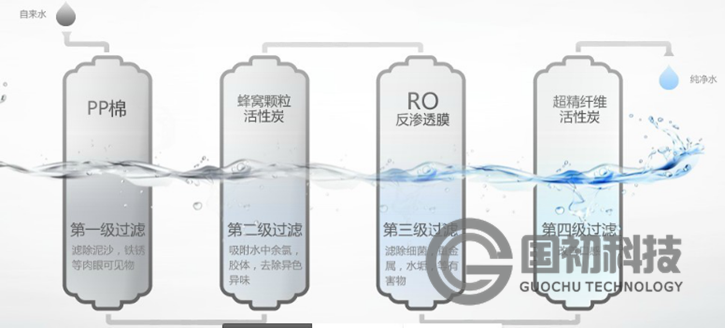Household water purification technology
Publisher:adminNumber of views:
Household water purifiers began in the 1950s and became popular in the 1970s, continuing to this day. Especially since the first discovery of disinfection by-products in tap water in the 20th century in the United States, many households in the United States began to install and use them as a self-protection device.
When one process is difficult to remove harmful substances from water, using two or more processes is considered a composite type. Such as activated carbon adsorption, ultraviolet sterilization, activated carbon adsorption, reverse osmosis, activated carbon adsorption, microfiltration (ultrafiltration), polypropylene ultrafine fibers, activated carbon, microfiltration (ultrafiltration), etc. In composite water purifiers, membrane technology composite water purifiers have excellent water purification performance, especially in the removal of microorganisms (bacteria, algae, etc.) with significant effects. Some high-quality water purifiers can directly drink raw water, which has been welcomed by consumers and has become a hot topic in the current development of water purifiers.
From the classification methods of water purifiers mentioned above, it is not difficult to see that household water purifiers are essentially miniaturized for advanced water treatment, mainly treating turbidity, chromaticity, odor, and organic matter in tap water. It generally consists of three parts: pre filtration (coarse filtration), adsorption, and fine filtration (microfiltration, ultrafiltration, and reverse osmosis). Among them, adsorption (usually using activated carbon adsorption) and fine filtration are the main methods for removing organic matter, odor, and chromaticity in water. The objective operating conditions directly affect the effluent quality of the water purifier. The service target of household water purifiers is thousands of households, but due to the significant differences in water quality and water pressure conditions in the regions where they are used, and the lack of necessary operational knowledge among users, product design cannot cope with the ever-changing situation. Therefore, the manufacturer of water purifiers should consider providing users with a certain level of professional knowledge, standardized installation and operation of water purifiers, and achieving the desired effluent quality.
When one process is difficult to remove harmful substances from water, using two or more processes is considered a composite type. Such as activated carbon adsorption, ultraviolet sterilization, activated carbon adsorption, reverse osmosis, activated carbon adsorption, microfiltration (ultrafiltration), polypropylene ultrafine fibers, activated carbon, microfiltration (ultrafiltration), etc. In composite water purifiers, membrane technology composite water purifiers have excellent water purification performance, especially in the removal of microorganisms (bacteria, algae, etc.) with significant effects. Some high-quality water purifiers can directly drink raw water, which has been welcomed by consumers and has become a hot topic in the current development of water purifiers.
From the classification methods of water purifiers mentioned above, it is not difficult to see that household water purifiers are essentially miniaturized for advanced water treatment, mainly treating turbidity, chromaticity, odor, and organic matter in tap water. It generally consists of three parts: pre filtration (coarse filtration), adsorption, and fine filtration (microfiltration, ultrafiltration, and reverse osmosis). Among them, adsorption (usually using activated carbon adsorption) and fine filtration are the main methods for removing organic matter, odor, and chromaticity in water. The objective operating conditions directly affect the effluent quality of the water purifier. The service target of household water purifiers is thousands of households, but due to the significant differences in water quality and water pressure conditions in the regions where they are used, and the lack of necessary operational knowledge among users, product design cannot cope with the ever-changing situation. Therefore, the manufacturer of water purifiers should consider providing users with a certain level of professional knowledge, standardized installation and operation of water purifiers, and achieving the desired effluent quality.







